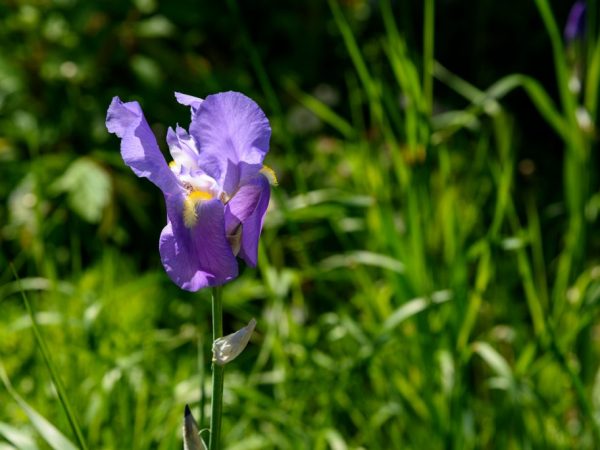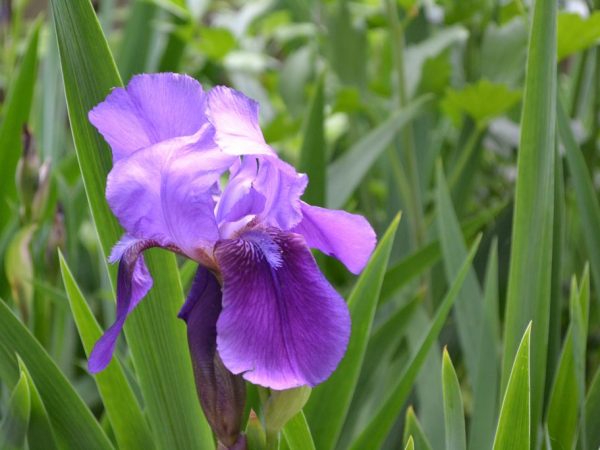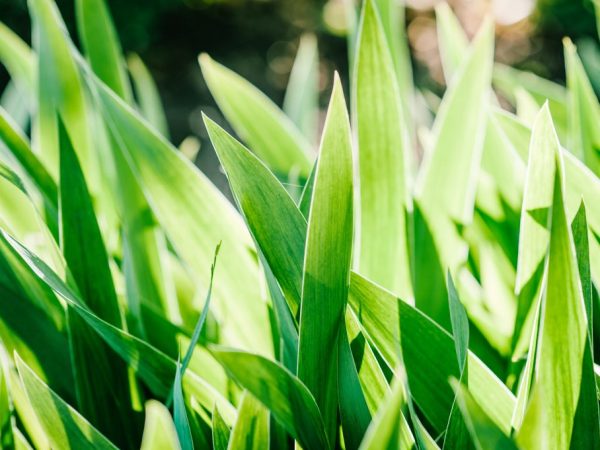Rules for caring for irises in autumn
Proper care of irises in autumn helps to prepare the flower culture for wintering and prevent freezing. It includes a number of mandatory measures aimed at increasing the overall frost resistance of the plant in preparation for winter.

Rules for caring for irises in autumn
Necessary activities
Autumn care for perennial irises includes several mandatory procedures:
- flower bushes are pruned;
- fertilize the soil;
- carry out preventive treatment of plants against infectious diseases and pests;
- flowers are covered for the winter to avoid freezing of the root system.
It is also a good time to divide the iris bush and transplant.
Pruning
They begin to cut the iris bush immediately after flowering, dividing this event into several stages:
- peduncles are cut off after budding to prevent the formation of a seed box, if it is not needed, because the plant spends a lot of energy on ripening seeds for reproduction, when pruning, they leave hemp no higher than 2 cm, which will help to avoid rotting;
- the leaves are not cut off until they wilt completely, because they participate in photosynthesis, support the nutrition of the flower and the accumulation of useful components in its roots before winter, only dried leaf plates and those that are affected by diseases or pests can be removed.
The yellow foliage is cut from September to October. These terms may shift depending on the regional characteristics of cultivation.
The vegetative mass is shortened to 12-15 cm at an angle, giving the shape of a pitched roof so that excess water flows down, does not remain on the cut stumps and does not provoke decay.
The trimmed parts are removed and burned. The vegetation left for the winter is a favorable environment for wintering pathogens of infectious diseases and larvae of pests, which in the spring, with the onset of heat, will be able to activate and harm the flower culture.
Transfer
After pruning, the irises are transplanted. This must be done if the bushes have grown too much, exposing the core, and the shoots with buds because of this begin to shrink. The transplantation and division of plants begins 2-3 weeks after the removal of the peduncles.
The procedure is carried out every 3-5 years.
The peculiarities of caring for growing irises are associated with their autumn planting in open ground. Bulbous varieties are dug up immediately after flowering, after about 2 weeks, and sent for summer storage until autumn.
To prevent the seedlings from freezing, they are covered with coniferous spruce branches or dry foliage.
Top dressing

Top dressing increases the frost resistance of plants
The main components required in the fall are potassium and phosphorus. They increase the overall frost resistance of the flower and help to cope with the cold in winter.
Nitrogen-containing compounds and fresh organic matter (manure, chicken droppings, compost) are not used, because they activate the growth of green mass and are able to provoke the growth of new aerial shoots, which will require additional nutrition.
Fertilizers are applied 2-3 weeks before the expected date of the first frost.
Iris is favorably influenced by:
- superphosphate (45-60 g / 1 m²);
- phosphate rock (up to 200 g / 1 m², every 5 years);
- potassium salt (25-30 g / 1 m²);
- wood ash (up to 250 g / 1 m²).
Instead of potassium and phosphorus-containing compounds, you can fertilize with mineral complexes:
- potassium monophosphate (50 g / 1 m²);
- phosphorus-potassium mixture (55 g / 1 m²);
- preparations developed for the care of flower crops (the application rate is indicated in the instructions).
I distribute dry and granular fertilizers in an even layer over the surface of the moistened area under the iris bushes, sprinkling it with earth on top and covering it with a rake to a depth of 3 cm.
Prevention of diseases and pests
In autumn, plants are treated against infectious diseases and pests. This helps to protect the irises from the preservation of pathogens and larvae.
Treatments for infection are carried out with fungicides:
- Fundazole (35 g / 10 L of water);
- Bordeaux liquid with a concentration of 1%;
- Qinebom (550 g / 10 l of water).
Protection against harmful insects is provided with insecticidal preparations:
- Karbofos (60 g / 8 l of water);
- Aktellik (2 ml / 2 l of water);
- Aktara (10 g / 10 l of water).
In addition to chemicals, they use folk recipes that enhance the effect of insecticides and fungicides and have deterrent properties for pests - infusions with tobacco, wood ash, onion husks.
Spraying is carried out after pruning the iris bushes.
Mulching and shelter for the winter

Flowers for the winter need to be covered
In the southern climatic zones, rice is not sheltered for the winter, because they can withstand small drops in temperature directly under the snow cover.
In the least favorable climatic areas, the flower culture will freeze and die without shelter.
There are varieties that cannot cope with the cold without protection. These include all Dutch and Japanese bulbous, tall and rhizomatous (comb, lake, unnamed).
Regardless of the growing region, it is imperative to cover young and newly planted irises and bushes with a bare root system.
Protect the ridges from winter cold by mulching, spreading a layer of 5-7 cm.As mulch are suitable:
- rotted manure or compost;
- peat crumb;
- coniferous bark;
- soil-sand mixture 1: 1;
- sawdust.
Many growers have given up mulching with leaf litter and straw, because such organics, when moisture enters, quickly decays and becomes a favorable environment for the development of fungal diseases.
In the northern regions, it is additionally recommended to lay a covering non-woven material, for example, agrofibre, on top of the mulch layer.
It is necessary to cover the flowers in October-November, when frosty weather finally sets in.
If the freezing of irises is observed year after year, they need to be dug up with a bookmark for storage for the winter. Do this after the foliage is completely yellow and dry. Store the bulbs that have been dried and treated with insecticides.
Summing up
Properly organized autumn care will provide iris with reliable protection from the cold and keep it healthy until spring. Timely preventive treatments with insecticidal and fungicidal preparations will save the plant from infection with infectious diseases and damage by pests.

